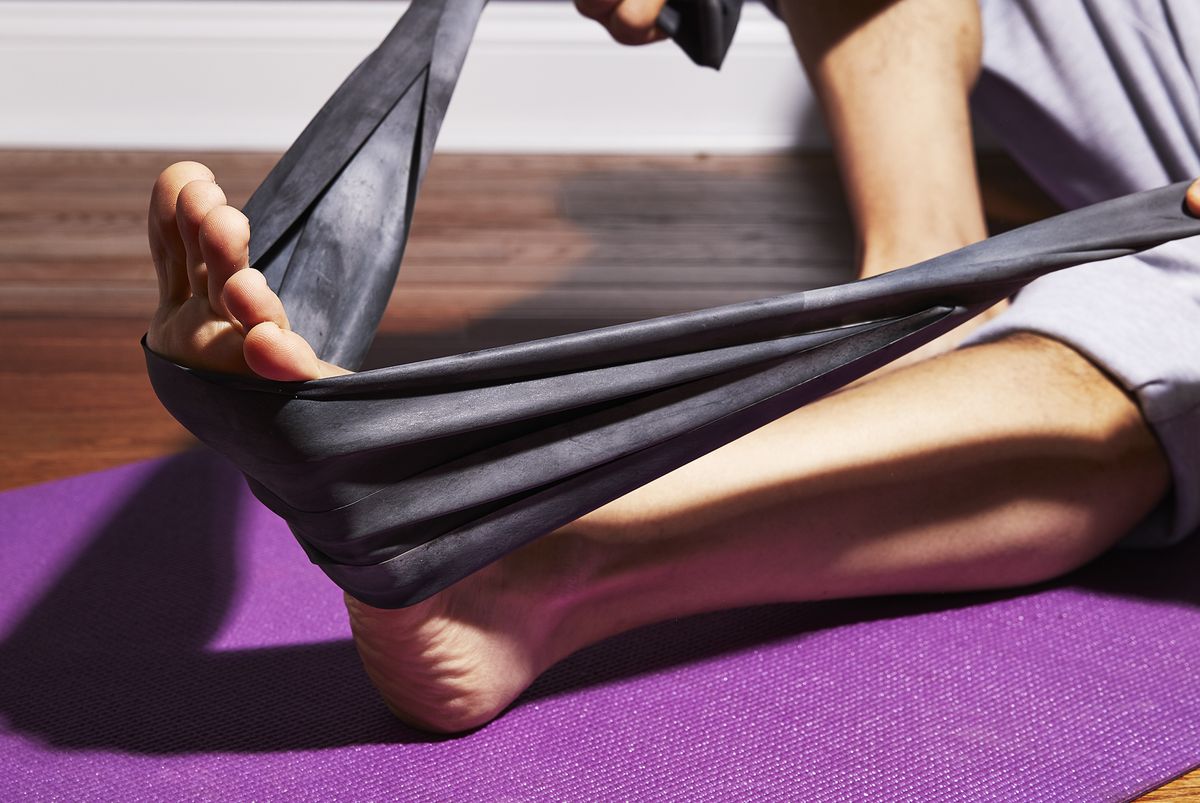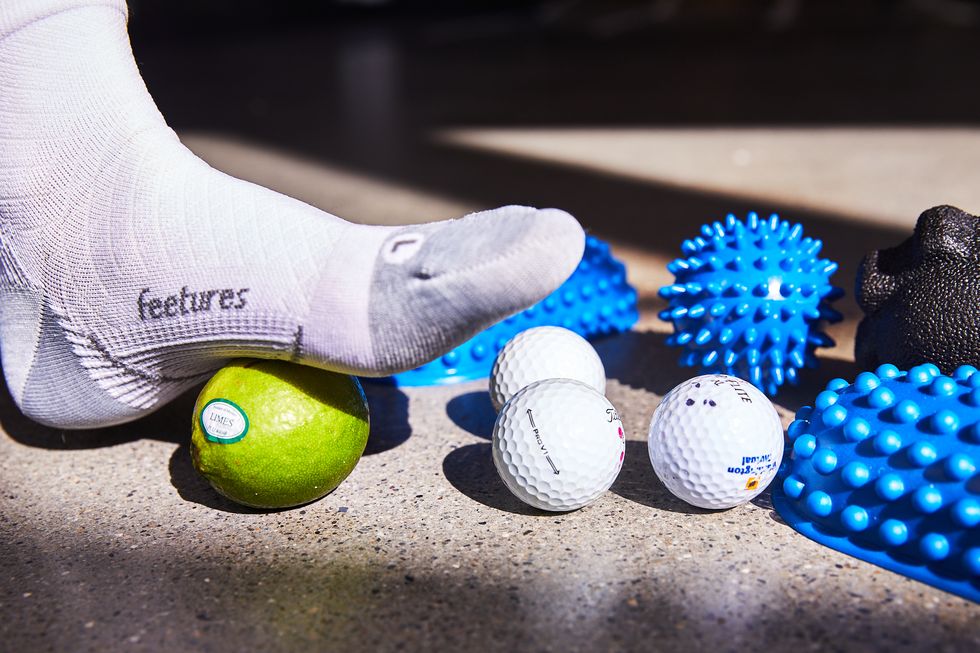The only good thing about plantar fasciitis is that it’s not a stress fracture: unlike an actual crack in a bone, it is possible to run through it and still heal the injury. But, that’s also part of the problem—it’s tempting to ignore pain and resist cutting down mileage. Some runners with mild cases can train through it successfully; the rest of us, like me, will learn that soldiering on with a handful of Advil and a prayer to Pre eventually escalates minor soreness into a full-blown flare up.
Plantar fasciitis, or PF, is caused by the inflammation of a thick band of tissues along the bottom of the foot. It feels like a sharp stab or deep ache in the heel or along the arch, and despite being an inflammatory condition, it rarely responds to treatment with anti-inflammatory drugs like ibuprofen. The plantar fascia connect your toes and heel, so you use them anytime you walk or simply stand, which can make PF a lingering, difficult condition to treat. As runners, we typically get it from overuse or during periods of intense training, like when you’re ramping up mileage for a marathon. It may resolve, only to return later and can frustrate runners on-and-off for years. Luckily, once you know it’s an issue for you, there are ways to stay ahead of it, help prevent it, and heal it more quickly.
I am not a medical doctor, physical therapist, podiatrist, or any variety of licensed foot guru—though I do have a biology minor (and a bronze medal from my seventh grade district spelling bee, helpful only in relentlessly googling “fasciitis.”) I’ve tried many of the most promising recommendations according to current research for treating plantar fasciitis, and I healed the injury without seeing a doctor. That said, don’t wait to make an appointment with your doc if you’re not getting relief—a custom treatment plan from a professional could be your fastest road back to running pain-free. If you’re curious to know what I did, you can read my exhaustive DIY treatment checklist below.
Ice and Massage
These were the first two things I tried once I started to experience symptoms, like a telltale sharp zinger of pain when I first put my feet on the floor in the morning. I’d also get a throb in my heel or through the arch that hurt only the first mile or so of my run, and then feel fine once the muscles loosened up. (I learned later that this is pretty common, and it’s a sign that you shouldn’t ignore.) I’d grit my teeth for the first mile or so, until it started taking three, then four miles to feel better. When I’d finished entire runs without ever getting relief, all the ice packs and foot rubs in the world weren’t going to actually heal the inflammation. But, they did still soothe some pain in the moment.
I assembled a recovery tool smorgasbord—these spiky balls, golf balls, Rollga’s 3-in-1 Activator, frozen water bottles, OPTP’s Pro-Pods, and even percussion massagers. But, I kept coming back to the ones I least expected, and also the simplest: a cold golf ball and a small frozen lime. With my palm, I gauged just the right sized lime to fit beneath my arch, and I found the fruit’s textured surface kept it from sliding out from under my foot like the slick golf ball sometimes would. (Experiment with other citrus fruits at your own discretion.) Plus, limes and golf balls are cheap—the latter were free actually, as I’d poached one abandoned Titleist from the roadside beyond a local golf course.
Stretching
This myofascial release technique and these calf stretches also helped soothe my very angry heel and arch. (It’s important to stretch and loosen both the plantar fascia itself, as well as the surrounding lower leg muscles like the calves and Achilles tendon.) While it’s typical to experience pain in just one foot, massage and stretch both feet. I did the stretches below first thing in the morning and three times during the day.
- Achilles Tendon Stretch: Stand with the affected foot behind the healthy one. Point the toes of your back foot toward the heel of your front foot and lean into a wall. Bend your front knee and keep your back knee straight with your heel firmly planted on the floor. Hold for 10 seconds. Repeat.
- Plantar Fascia Stretch: Sit down, and place the foot with heel pain across your knee. Using your hand on the side affected by plantar fasciitis, pull your toes back toward your shin until you feel a stretch in your arch. Hold for 10 seconds. Run your thumb along your foot—you should feel tension. Repeat.
Socks, Splints, and Tape
Poring over research studies, blogs, and message boards with personal accounts of other PF-sufferers led to an important realization. The successful treatment methods are super individual—cures and tricks that some runners swore by did nothing for others. For me, two examples of those were Strassburg socks and night splints. While they gave me some initial relief for the first step out of bed and hobbling around in the early morning, the rest of the day’s pain was not much improved. (And, I found them terribly annoying to sleep in.) I also tried various taping methods without much success. Still, both research and other anecdotal evidence indicate that splints and tape do help some individuals recover. Experiment with a few strategies and see what works. Just because they weren’t my magic cure doesn’t mean they won’t help you.
I did find plantar fasciitis-specific compression socks helpful. They added more support than regular socks for cross-training, but didn’t bother me as much as a night splint while I slept. Ideally, I’m a barefoot sleeper, but this pair was a decent compromise to let my toes breathe. Any pair of compression socks can boost blood flow and improve circulation, which helps the inflamed tissues heal. (Part of the reason it takes PF so long to resolve is because the plantar fascia doesn’t receive a lot of blood.)
Cross-Training
Initially, I reduced my running mileage to only 10 percent of usual, a recommendation made in articles by Jordan Metzl, M.D., a sports medicine physician at the Hospital for Special Surgery in New York City. After about a month of running a few miles per week and cross-training for the remainder without major improvement, I reassessed. In my case, this approach was just drawing out the injury. I settled on sidelining myself from all running for two full weeks, period. I’d re-evaluate from there. Even the elliptical and stair climber caused some twinges of pain, so I divided my time between swimming, aqua-jogging, and biking at the local gym.
The easiest way I found to replicate my running effort while cross-training was to train by heart rate using the wrist-based sensor on my watch. You can aim for higher heart rate zones to simulate more rigorous speed or hill workouts, but I just tried to keep my bpm within the same target range as my easy runs. My goal was piecing together workouts that mimicked running’s cardiovascular strain and also helped me retain good running form for when I was back on land. The assault bike allowed me to get my heart rate up higher than a regular stationary bike, but I couldn’t turn the pedals around quickly enough to replicate my usual stride rate. So, I also used the stationary bike at a lower resistance, which felt closer to my cadence of 170-ish steps per minute. Capable cyclists can spin around 85 rpm, but as a newbie, I found the 60 to 70 range sufficiently challenging. And when I got bored with the bikes, I swam freestyle laps in the pool—followed up with some aqua-jogging to focus on stride and turnover in the water.
Here’s what I used as an imperfect conversion between running and cross-training mileage:
- Swim: Relaxed freestyle stroke for same run time
- Spin Bike: Multiply run mileage by 3
- Aqua Jog: Multiply run time by 1.5
- Elliptical: Multiply run time by 2
Returning to Running and Preventing Future Flare Ups
After two weeks, I eased back into running at half of my typical mileage, supplementing land miles with those on the bike or in the pool. Any days I felt any pain, I backed off on running and stayed off my foot. I also added a second pair of shoes into my running rotation in order to switch up the drop and vary the amount of cushioning. Rotating your shoes lessens the chance you’ll overuse specific muscles, helpful in preventing both plantar fasciitis and other injuries. If you know you’ll be increasing your mileage or intensity soon, start incorporating some stretches, massage, and foot strengthening exercises into your run routine now. While I can’t say they’ve helped me PR, I can say that my PF hasn’t returned, and I’ve been back to training at my usual volume for seven months.















